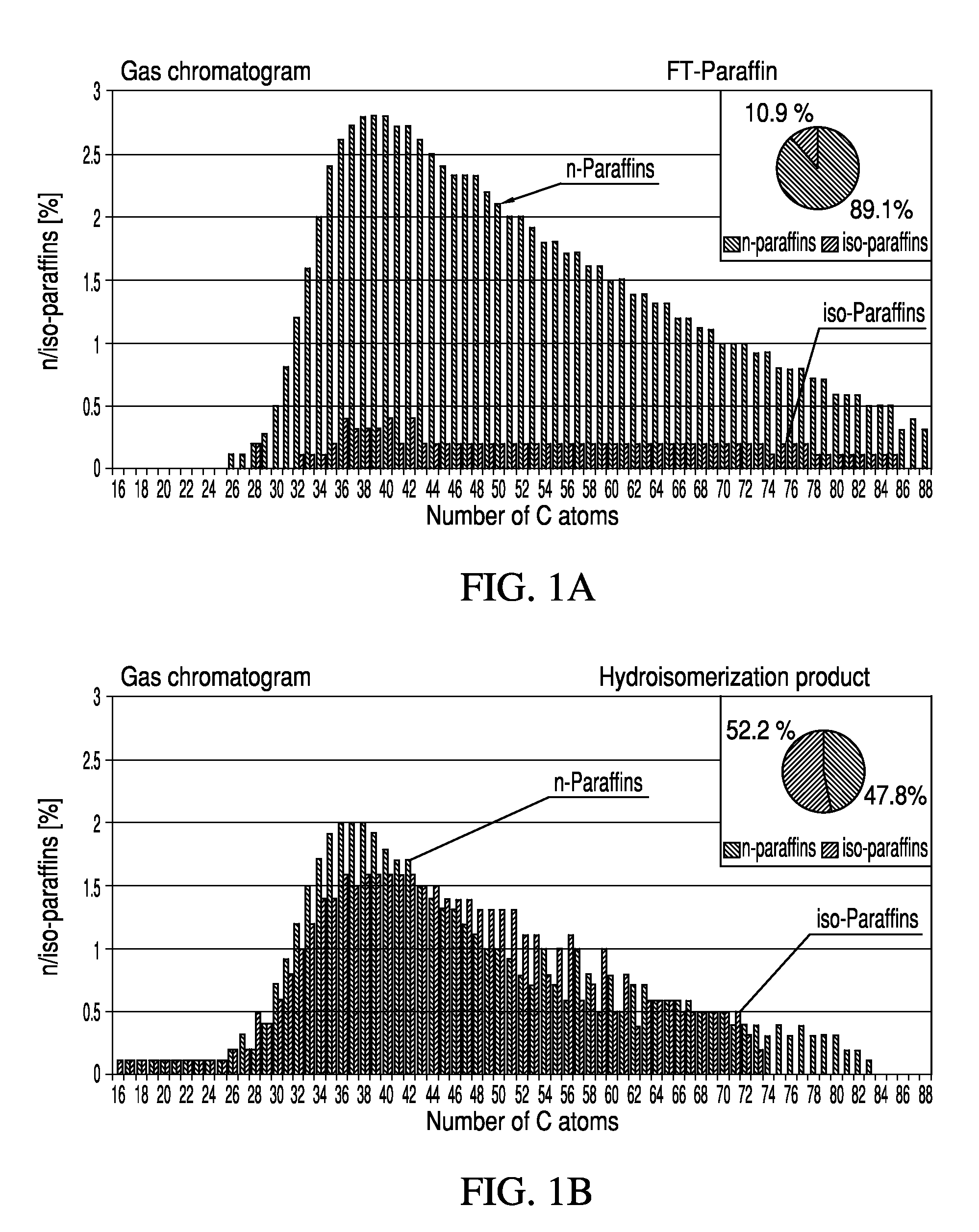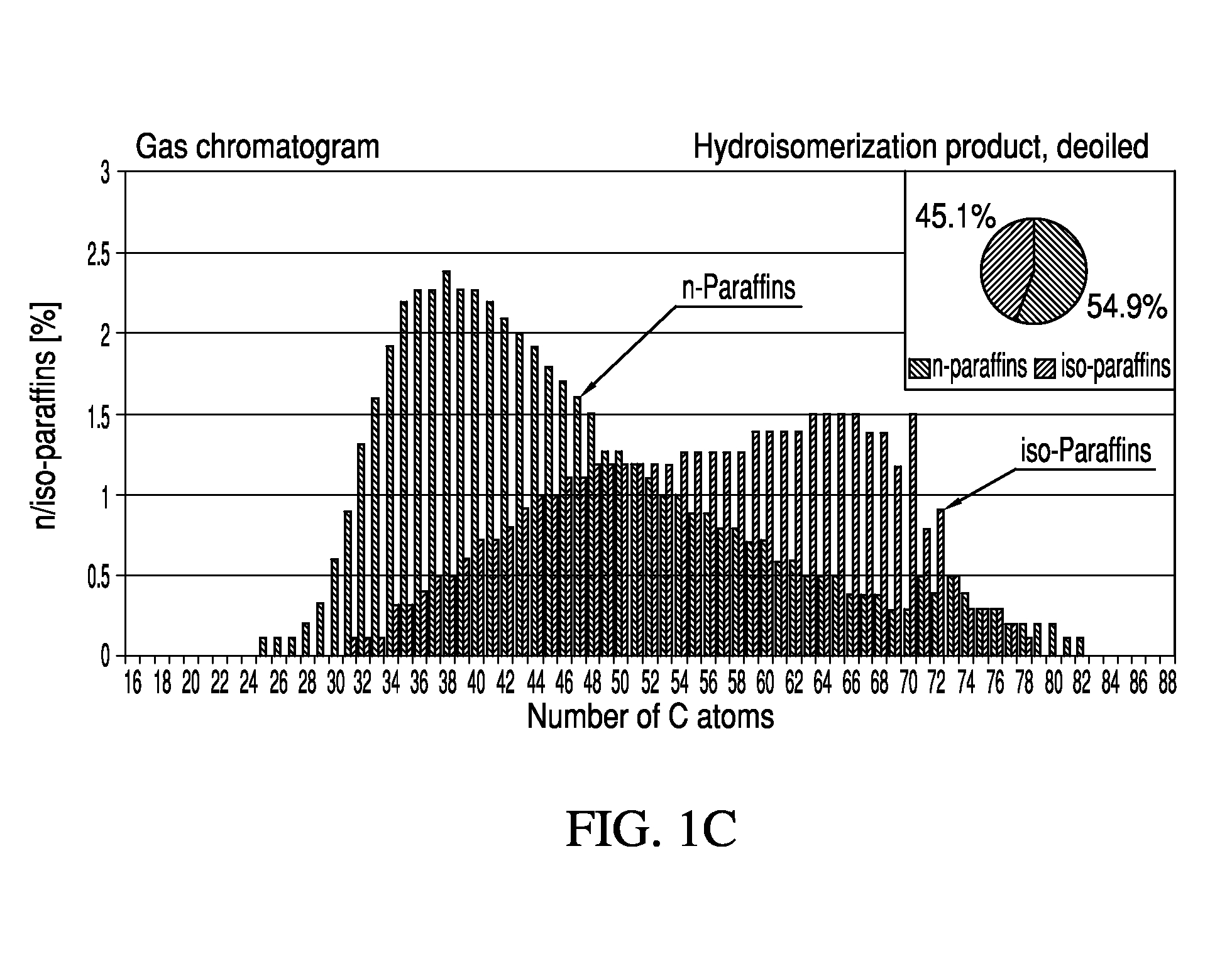Microcrystalline paraffin
a microcrystalline paraffin and paraffin technology, applied in the field of microcrystalline paraffin, can solve the problems of complex and expensive process having a plurality of stages, and achieve the effect of good metal adhesion
- Summary
- Abstract
- Description
- Claims
- Application Information
AI Technical Summary
Benefits of technology
Problems solved by technology
Method used
Image
Examples
example 1
[0048]An FT paraffin having a solidification point at 97° C. was catalytically isomerized with hydrogen at a pressure of 5 MPa (50 bar), a temperature of 270° C. and a v / v.h ratio of 0.3. The resulting hydroisomerization was demonstrated by characteristics in table 1.
[0049]The hydroisomerization product is white, odorless and slightly tacky and thus differs substantially from the brittle starting material. The isoalkane fraction is increased about 6-fold, which is demonstrated by the increased penetration value, the reduced crystallinity and the reduced enthalpy of fusion. On the basis of its characteristics, the synthetic, microcrystalline paraffin thus prepared is to be classified between a plastic and a hard microwax based on mineral oil. The hydroisomerization product was thus a paraffin having a pronounced microcrystalline structure, whose C chain length distribution of from 23 to 91 carbon atoms corresponds approximately to that of the starting material with from 27 to 95, but...
example 2
[0050]An FT paraffin having a solidification point at 70° C. was catalytically isomerized with hydrogen at a pressure of 5 MPa (50 bar), a temperature of 250° C. and a v / v.h ratio of 0.3. The resulting structural conversion was demonstrated by the characteristics in the table.
[0051]The hydroisomerization product is white and odorless as well as pasty and slightly tacky. The isoalkane fraction is increased about 5-fold. The high degree of isomerization is expressed in the substantially increased penetration value, the reduced crystallinity and the reduced enthalpy of fusion. The microcrystalline paraffin thus obtained has a similar but slightly reduced C chain length compared with the FT paraffin, which is clear from the carbon atoms: from 23 to 42 in the case of the hydroisomerization product and from 25 to 48 in the case of the FT paraffin. On the basis of its characteristics, the synthetic microcrystalline paraffin thus prepared is comparable to a soft plastic microcrystalline par...
example 3
[0054]A catalyst (cylindrical extrudate, diameter 1.5 mm, length about 5 mm) was used in uncomminuted form. 92 ml of catalyst were introduced in undiluted form into the reactor tube (total volume 172 ml, internal diameter 22 mm). The catalyst zone was also covered with a layer of the earth material. A thermocouple was positioned in the reactor in such a way that the temperature was measured at a depth of 2 cm and 17 cm of the catalyst bed. The catalysts were dried and activated (by means of high temperature, water is expelled and platinum reduced).
[0055]The paraffin starting material used was an FT paraffin C80 (solidification point 81° C., n-paraffin / isoparaffin mass ratio: 93.9 / 6.1). The oil content of the starting material was 0.5%. The needle penetration value was 6.0.
[0056]The experiments were carried out at a hydrogen pressure of 50 bar.
[0057]The following results were obtained: at 260° C. and 0.96 v / v.h, the iso fraction (% by mass) increased from 6.1 (FT paraffin) to 42 (hyd...
PUM
| Property | Measurement | Unit |
|---|---|---|
| temperature | aaaaa | aaaaa |
| pore size | aaaaa | aaaaa |
| pore size | aaaaa | aaaaa |
Abstract
Description
Claims
Application Information
 Login to View More
Login to View More - R&D
- Intellectual Property
- Life Sciences
- Materials
- Tech Scout
- Unparalleled Data Quality
- Higher Quality Content
- 60% Fewer Hallucinations
Browse by: Latest US Patents, China's latest patents, Technical Efficacy Thesaurus, Application Domain, Technology Topic, Popular Technical Reports.
© 2025 PatSnap. All rights reserved.Legal|Privacy policy|Modern Slavery Act Transparency Statement|Sitemap|About US| Contact US: help@patsnap.com



